Importance of Corporate Social Responsibility in Shaping Supply Chain Management: The Case of Sportswear Apparel
Added on 2023-01-17
28 Pages10837 Words50 Views
Importance of Corporate
Social Responsibility in
shaping supply chain
management: The case of
sportswear apparel
Social Responsibility in
shaping supply chain
management: The case of
sportswear apparel
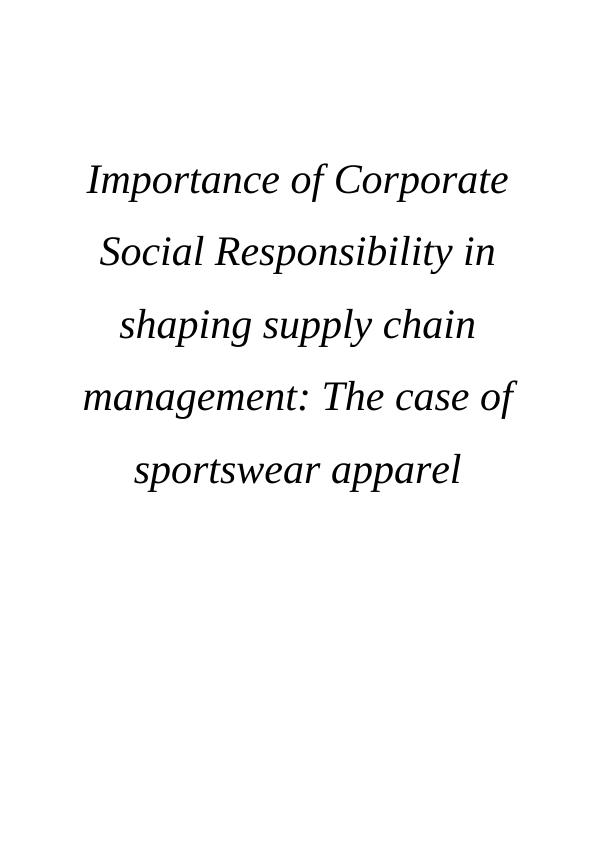
Table of ContentsCHAPTER 1: INTRODUCTION..............................................................................................3
1.1 Background of the research....................................................................................................3
1.2 Company Background............................................................................................................5
1.3 Problem statement.................................................................................................................6
1.4 Value & Significance of Research............................................................................................7
1.5 Rationale................................................................................................................................7
1.6 Research Aims........................................................................................................................7
1.7 Research Objectives................................................................................................................7
1.8 Research questions.................................................................................................................8CHAPTER 2: LITERATURE REVIEW.......................................................................................8
2.1 Introduction............................................................................................................................8
2.2 The evolution of corporate social responsibility (CSR) activities.............................................8
2.3 The importance of CSR activities and Supply chain management for Nike and Puma.............9
2.4 To ascertain the benefits which Nike and Puma will get with sustainable supply Chain.......11
2.5 To ascertain the ways through which CSR can improve the Supply chain management
practices of Nike and Puma........................................................................................................12
2.6 CSR and ethical behaviour ....................................................................................................13CHAPTER 3: RESEARCH METHODOLOGY..........................................................................14
3.1 Introduction..........................................................................................................................14
3.2 Research approach...............................................................................................................14
3.3. Research strategy................................................................................................................15
3.4 Research Methods...............................................................................................................15
3.5 Ethical considerations...........................................................................................................16
3.6 Limitations ...........................................................................................................................16CHAPTER 4: DATA ANALYSIS.............................................................................................17
4.1 Introduction..........................................................................................................................17
4.2 CSR and sustainability in the sportwear industry with backward referencing to sources used
in literature review. ...................................................................................................................17
4.3 How Nike incorporates CSR in its supply chain......................................................................18
4.4 How Puma incorporate CSR in their supply chain.................................................................19
4.5 DISCUSSION..........................................................................................................................19CHAPTER 5: CRITICAL ANALYSIS DISCUSSION AND CONCLUSION......................................21
5.1 Conclusion............................................................................................................................21
5.2 RECOMMENDATION.............................................................................................................22
5.4 LIMITATIONS.........................................................................................................................23
1.1 Background of the research....................................................................................................3
1.2 Company Background............................................................................................................5
1.3 Problem statement.................................................................................................................6
1.4 Value & Significance of Research............................................................................................7
1.5 Rationale................................................................................................................................7
1.6 Research Aims........................................................................................................................7
1.7 Research Objectives................................................................................................................7
1.8 Research questions.................................................................................................................8CHAPTER 2: LITERATURE REVIEW.......................................................................................8
2.1 Introduction............................................................................................................................8
2.2 The evolution of corporate social responsibility (CSR) activities.............................................8
2.3 The importance of CSR activities and Supply chain management for Nike and Puma.............9
2.4 To ascertain the benefits which Nike and Puma will get with sustainable supply Chain.......11
2.5 To ascertain the ways through which CSR can improve the Supply chain management
practices of Nike and Puma........................................................................................................12
2.6 CSR and ethical behaviour ....................................................................................................13CHAPTER 3: RESEARCH METHODOLOGY..........................................................................14
3.1 Introduction..........................................................................................................................14
3.2 Research approach...............................................................................................................14
3.3. Research strategy................................................................................................................15
3.4 Research Methods...............................................................................................................15
3.5 Ethical considerations...........................................................................................................16
3.6 Limitations ...........................................................................................................................16CHAPTER 4: DATA ANALYSIS.............................................................................................17
4.1 Introduction..........................................................................................................................17
4.2 CSR and sustainability in the sportwear industry with backward referencing to sources used
in literature review. ...................................................................................................................17
4.3 How Nike incorporates CSR in its supply chain......................................................................18
4.4 How Puma incorporate CSR in their supply chain.................................................................19
4.5 DISCUSSION..........................................................................................................................19CHAPTER 5: CRITICAL ANALYSIS DISCUSSION AND CONCLUSION......................................21
5.1 Conclusion............................................................................................................................21
5.2 RECOMMENDATION.............................................................................................................22
5.4 LIMITATIONS.........................................................................................................................23
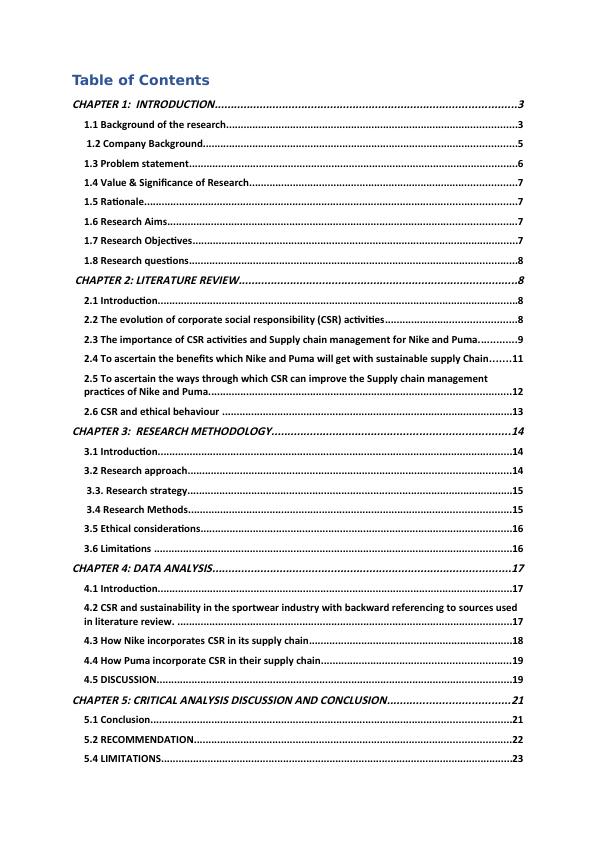
REFERENCES.....................................................................................................................24
CHAPTER 1: INTRODUCTION
Many Consumers do not know under which conditions the products are manufactured.
Many of the workers worked in unfavourable conditions, still the goods which are produced
are sold at higher prices. Some organisations use child labour, which is prohibited (Unicef,
2017). Practices like this must be abolished by companies as in order to perform their
operations ethically and bring up positive influence over the society (Grayson and Hodges,
2017). This is so because an organisation has to represent or publish the way they operate
thanks to Corporate Social Responsibility (CSR), which had made a massive impact on these
companies. This chapter involve an overview regarding the factors or areas that are involved
within this study. In addition to this it also represents the aims and objectives, background of
company as well as value of the research.
1.1 Background of the research
Corporate social responsibility (CSR) defines as the self-regulating business model,
which supports an organisation to remain socially accountable for its stakeholders, itself, as
well as the public (Crane, Matten and Spence,2019) It involves a set of activities performed
by an organisation that brings up a positive impact on the social, economic, and
environmental factors. The CSR practices play a significant role within the growth, and the
success of an organisation as a socially responsible company become able to gain the trust of
its stakeholder in a significant manner which in turn influence their decision in a positive way
for contributing towards organisation growth as well as success (Amini and Bienstock, 2014).
On the other hand, supply chain management refers to the process of managing the flow of
raw material, work-in-progress, inventory, goods, or services from the place of its origin to
final consumption (Daniel, 2020). Effective supply chain practices supports an organisation
to effectively manage the demand, deal with disruption, meeting customer demand, carrying
the right amount of inventory, etc. (Bostrom, 2014).The CSR practices not performed
individually by the owners of an organisation instead, it requires the involvement of all its
stakeholders for implementing practices related to social responsibility (Bernstein 2020).
Hence an organisation must focus on involving its close stakeholders in CSR practices for
bringing up positive responses.
CHAPTER 1: INTRODUCTION
Many Consumers do not know under which conditions the products are manufactured.
Many of the workers worked in unfavourable conditions, still the goods which are produced
are sold at higher prices. Some organisations use child labour, which is prohibited (Unicef,
2017). Practices like this must be abolished by companies as in order to perform their
operations ethically and bring up positive influence over the society (Grayson and Hodges,
2017). This is so because an organisation has to represent or publish the way they operate
thanks to Corporate Social Responsibility (CSR), which had made a massive impact on these
companies. This chapter involve an overview regarding the factors or areas that are involved
within this study. In addition to this it also represents the aims and objectives, background of
company as well as value of the research.
1.1 Background of the research
Corporate social responsibility (CSR) defines as the self-regulating business model,
which supports an organisation to remain socially accountable for its stakeholders, itself, as
well as the public (Crane, Matten and Spence,2019) It involves a set of activities performed
by an organisation that brings up a positive impact on the social, economic, and
environmental factors. The CSR practices play a significant role within the growth, and the
success of an organisation as a socially responsible company become able to gain the trust of
its stakeholder in a significant manner which in turn influence their decision in a positive way
for contributing towards organisation growth as well as success (Amini and Bienstock, 2014).
On the other hand, supply chain management refers to the process of managing the flow of
raw material, work-in-progress, inventory, goods, or services from the place of its origin to
final consumption (Daniel, 2020). Effective supply chain practices supports an organisation
to effectively manage the demand, deal with disruption, meeting customer demand, carrying
the right amount of inventory, etc. (Bostrom, 2014).The CSR practices not performed
individually by the owners of an organisation instead, it requires the involvement of all its
stakeholders for implementing practices related to social responsibility (Bernstein 2020).
Hence an organisation must focus on involving its close stakeholders in CSR practices for
bringing up positive responses.
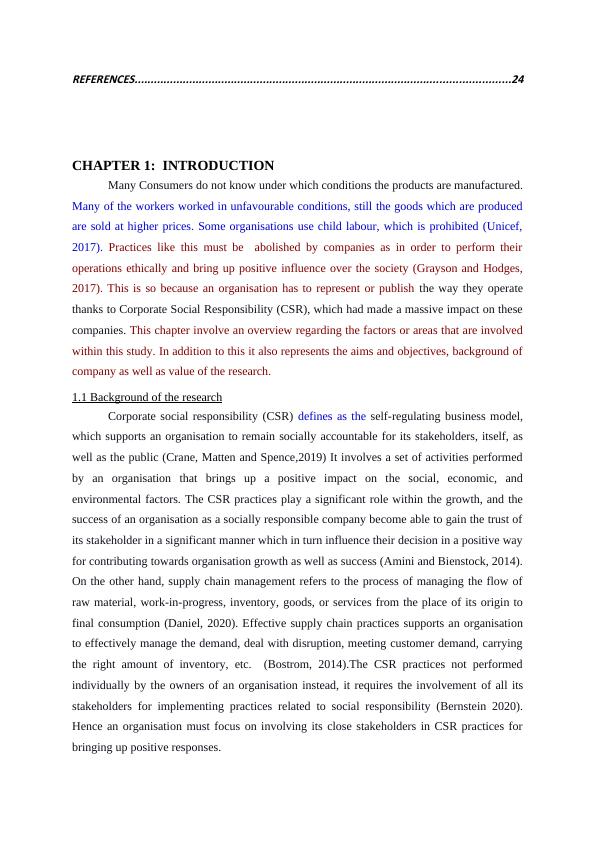
The current report is based on the topic “Importance of Corporate Social
Responsibility in shaping supply chain management: The case of sportswear apparel Nike
and Puma” and for conducting this study Nike and Puma is taken into consideration, which
are both large multinational organisations and deals in offering products or services related
with footwear and apparels along with the accessories in sports category. Both the
organisations are proliferating by providing a variety of products or services associated with
sports and other divisions by maintaining a range of physical as well as online channels for
offering its commodities to customers (Gualandris and Kalchschmidt, 2014). To protect its
brand, in 2004, Nike became active and acknowledging human rights and increased their
monitoring efforts on their plants and factories (Nisen, 2013). As a result of that, in 2005,
Nike became the first company in its industry to provide a thorough list of the factories they
worked with and the revealed working conditions and wages (Poker, 2016).
This success becomes possible due to the effective management of the supply chain,
but it is not remaining enough to sustain in the market. As companies related with apparels as
well as accessories involve tremendous amount of wastage or a manufacturing process that
directly harms the environment, therefore, to deal with this issue majority of organizations
started getting involved in CSR practices, Nike and Puma are two among them by putting
more emphases toward the set of activities performed by the suppliers. Majority of
organisations putting emphasis on encouraging the supplier towards achieving eco-friendly
activities by reducing wastage, pollution, controlling gas emissions, and encouraging them to
comply with government regulation and policies (Ayers and Odegaard, 2017). So that they
can contribute towards the safety and welfare of environment by getting involved in several
CSR practices and at the same time maintain profitability. Therefore, nowadays, CSR
practices are also involved by the organisations in its supply chain management which helps
them in increasing their profitability while reducing the cost as well as wastage. This is so
because while supplying the raw material and other things through different channels, there is
a more substantial number of issues that may get arises at a different end of the supply chain
cycle, which leads to an increase in wastage. These waste materials usually aren’t properly
disposed of by the channel members and as a result of which it directly harms the
environment. These things are especially prevalent in the footwear sector, where the
organisation is using such material for manufacturing that can't get adequately disposed of,
such as plastic, rubber, etc. (Tippayawong and Tippayawong, 2017). Hence the waste
material from all these do not get disposed of fully, and on the other side also brings a huge
influence over the environment. Therefore, it can be said that CSR helps in shaping up the
Responsibility in shaping supply chain management: The case of sportswear apparel Nike
and Puma” and for conducting this study Nike and Puma is taken into consideration, which
are both large multinational organisations and deals in offering products or services related
with footwear and apparels along with the accessories in sports category. Both the
organisations are proliferating by providing a variety of products or services associated with
sports and other divisions by maintaining a range of physical as well as online channels for
offering its commodities to customers (Gualandris and Kalchschmidt, 2014). To protect its
brand, in 2004, Nike became active and acknowledging human rights and increased their
monitoring efforts on their plants and factories (Nisen, 2013). As a result of that, in 2005,
Nike became the first company in its industry to provide a thorough list of the factories they
worked with and the revealed working conditions and wages (Poker, 2016).
This success becomes possible due to the effective management of the supply chain,
but it is not remaining enough to sustain in the market. As companies related with apparels as
well as accessories involve tremendous amount of wastage or a manufacturing process that
directly harms the environment, therefore, to deal with this issue majority of organizations
started getting involved in CSR practices, Nike and Puma are two among them by putting
more emphases toward the set of activities performed by the suppliers. Majority of
organisations putting emphasis on encouraging the supplier towards achieving eco-friendly
activities by reducing wastage, pollution, controlling gas emissions, and encouraging them to
comply with government regulation and policies (Ayers and Odegaard, 2017). So that they
can contribute towards the safety and welfare of environment by getting involved in several
CSR practices and at the same time maintain profitability. Therefore, nowadays, CSR
practices are also involved by the organisations in its supply chain management which helps
them in increasing their profitability while reducing the cost as well as wastage. This is so
because while supplying the raw material and other things through different channels, there is
a more substantial number of issues that may get arises at a different end of the supply chain
cycle, which leads to an increase in wastage. These waste materials usually aren’t properly
disposed of by the channel members and as a result of which it directly harms the
environment. These things are especially prevalent in the footwear sector, where the
organisation is using such material for manufacturing that can't get adequately disposed of,
such as plastic, rubber, etc. (Tippayawong and Tippayawong, 2017). Hence the waste
material from all these do not get disposed of fully, and on the other side also brings a huge
influence over the environment. Therefore, it can be said that CSR helps in shaping up the
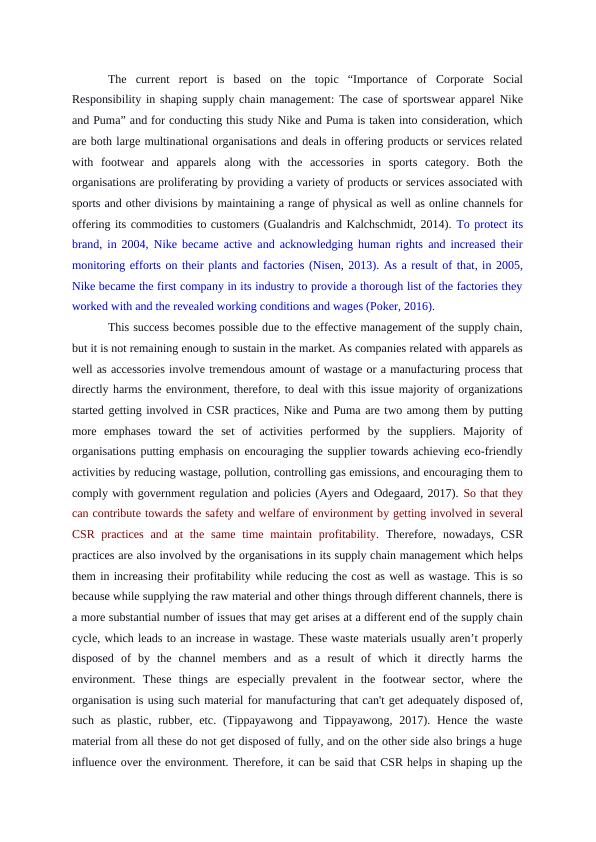
supply chain management as CSR practices involve making use of raw material that is eco-
friendly and does not harm the environment (Chkanikova and Mont, 2015). Despite this, it
also consists in using raw material in an efficient manner so that wastage can be minimized
which in turn brings efficiency in supply chain management and when the activities are
governed as per the government regulations and practices then it generates fewer chances of
legal compliances which ensure smooth flow of operations (Collier, 2018).
Pressure groups find it challenging to get the attention of global brands, so they now
look into where brands like Nike and Puma source their products. (Amaneshi et al. 2008).
The rise of multimedia communication makes it easier for any unethical practices by their
suppliers to be brought to the public’s attention.
A perfect example is Nike's, case which brought them negative attention as a
company. Their production sites were making use of child labour and poor wages (Teather,
2005). Even though Nike wasn’t directly doing this, they were forced to take responsibility
for the impudent behaviours of their suppliers to protect their brand.
1.2 Company Background
Both the organisations come under the apparel, accessories, and sports equipment as they
mainly offer products related to footwear as well as sports-related things. Both the
organisation are competitors of one another as both deals in the same market and offer similar
kinds of products or services. The background of both organisations is mentioned below:
Nike: - The Nike Incorporation is an American multinational organisation that works
toward designing, developing, manufacturing as well as marketing and sales of footwear,
equipment, apparel, and accessories. Nike was founded in the year 1964 and headquartered in
the Portland metropolitan area with Beaverton, Oregon. Within the early 21st century, Nike
had its retail outlet as well as distributor within more than 170 countries, and after that, its
logo, a curvy checkmark known as "swoosh," get recognised throughout the world (Nike,
Inc., 2020).
Later in year 1980s, Nike steadily expanded its business and diversified the product
line through several acquisitions that include shoe companies Cole Haan, Converse Inc.,
athletic and equipment company Umbro, and Canstar Sports Inc. Later on, the company
started offering sports technology accessories which include heart rate monitors, high altitude
wrist compasses. The main reason for its success is that the brand adopts an endorsement
strategy where it gets endorsed by athletes such as Mia Hamm, Tiger Wood, Michael Jordon,
etc. (THE POWER OF SPORT TO MOVE THE WORLD, 2020). It is the world's largest
friendly and does not harm the environment (Chkanikova and Mont, 2015). Despite this, it
also consists in using raw material in an efficient manner so that wastage can be minimized
which in turn brings efficiency in supply chain management and when the activities are
governed as per the government regulations and practices then it generates fewer chances of
legal compliances which ensure smooth flow of operations (Collier, 2018).
Pressure groups find it challenging to get the attention of global brands, so they now
look into where brands like Nike and Puma source their products. (Amaneshi et al. 2008).
The rise of multimedia communication makes it easier for any unethical practices by their
suppliers to be brought to the public’s attention.
A perfect example is Nike's, case which brought them negative attention as a
company. Their production sites were making use of child labour and poor wages (Teather,
2005). Even though Nike wasn’t directly doing this, they were forced to take responsibility
for the impudent behaviours of their suppliers to protect their brand.
1.2 Company Background
Both the organisations come under the apparel, accessories, and sports equipment as they
mainly offer products related to footwear as well as sports-related things. Both the
organisation are competitors of one another as both deals in the same market and offer similar
kinds of products or services. The background of both organisations is mentioned below:
Nike: - The Nike Incorporation is an American multinational organisation that works
toward designing, developing, manufacturing as well as marketing and sales of footwear,
equipment, apparel, and accessories. Nike was founded in the year 1964 and headquartered in
the Portland metropolitan area with Beaverton, Oregon. Within the early 21st century, Nike
had its retail outlet as well as distributor within more than 170 countries, and after that, its
logo, a curvy checkmark known as "swoosh," get recognised throughout the world (Nike,
Inc., 2020).
Later in year 1980s, Nike steadily expanded its business and diversified the product
line through several acquisitions that include shoe companies Cole Haan, Converse Inc.,
athletic and equipment company Umbro, and Canstar Sports Inc. Later on, the company
started offering sports technology accessories which include heart rate monitors, high altitude
wrist compasses. The main reason for its success is that the brand adopts an endorsement
strategy where it gets endorsed by athletes such as Mia Hamm, Tiger Wood, Michael Jordon,
etc. (THE POWER OF SPORT TO MOVE THE WORLD, 2020). It is the world's largest
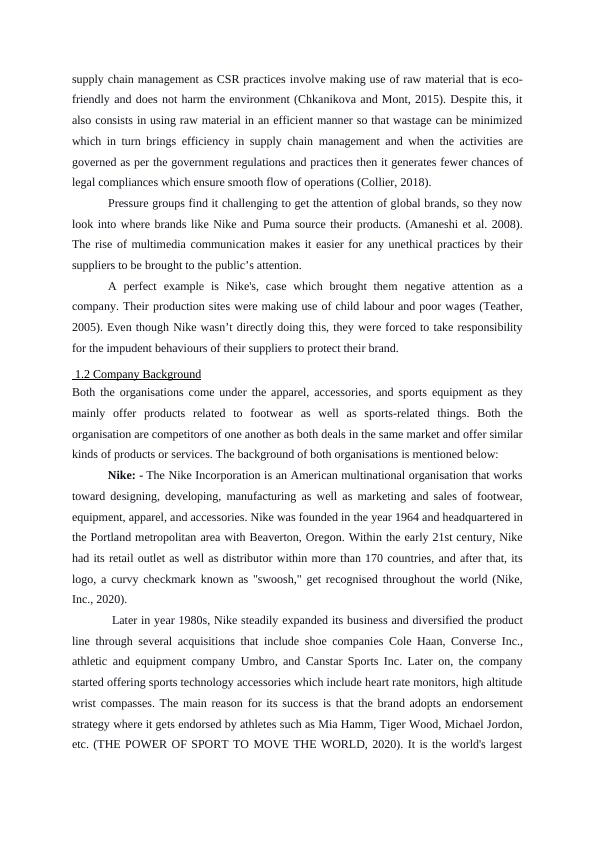
supplier of apparel and athletic shoes as a major manufacturer of sports equipment. Its
primary mission is to drive everything possible to expand the potential of the human. It
creates ground-breaking sports innovation for developing the product more sustainably by
building up a more creative and diverse global team to make a positive impact on the
community. Nike Inc. work while viewing everybody as an athlete that is united in the joy of
movement. Whether the task is to design a sneaker or to code the revolutionary app, Nike
works over a single mission, i.e., "Bringing inspiration as well as innovation to every athlete
within the world" (THE POWER OF SPORT TO MOVE THE WORLD, 2020).
Puma: - It is a German multinational company that operates as a designer as well as a
manufacturer of casual and athletic footwear, accessories, and apparel. It is headquartered
within Herzogenaurach, Bavaria, Germany, and ranked as third-largest sportswear
manufacturer in the world (Gulden, 2018). Puma founded as one of the leading athletic
footwear, accessories, and apparel company within the world that began its operations within
the year 1924 when the founder of the company, i.e., Rudolph Dassler, started a
manufacturing company with his brother named as Adolf. At that time, it was a family
business that mainly produces slippers as well as outdoor shoes when they identified the need
for athletic shoes within the market. After this, during the year 1928 Olympics, Puma gained
national attention when nearly half of the participants of sports wore Dassler shoes (PUMA,
2020). Today, Puma maintains an impressive as well as a versatile collection of accessories,
apparel, and footwear. It offers a variety of products which include Basketball, Running,
Training, Football, Golf, Sport style, Motorsports, Fitness, etc. In the past time, it sponsored a
range of legendary athletes such as Pelé, Eusébio, Diego Maradona, Lothar Matthaus, Clyde
Frazier, Jim Hines, Boris Becker, Johan Cruyff, Colin Jackson, Heike Drechsler, Martina
Navratilova, Tommie Smith, Joe Namath, Linford Christie, and Michael Schumacher among
others.
1.3 Problem statement
The main problem over which current study focused is about the role of corporate
social responsibility which is to be followed while managing supply chain. This is so because
the organisations mainly performed CSR practices in several different area of a business but
mainly fails to involve supply chain management into it, which is a major concern within the
society. As there are number of channel members that plays a significant role within
manufacturing of products to its final consumption. These channel members perform range of
practices which may results into wastage that affect environment which may become a major
primary mission is to drive everything possible to expand the potential of the human. It
creates ground-breaking sports innovation for developing the product more sustainably by
building up a more creative and diverse global team to make a positive impact on the
community. Nike Inc. work while viewing everybody as an athlete that is united in the joy of
movement. Whether the task is to design a sneaker or to code the revolutionary app, Nike
works over a single mission, i.e., "Bringing inspiration as well as innovation to every athlete
within the world" (THE POWER OF SPORT TO MOVE THE WORLD, 2020).
Puma: - It is a German multinational company that operates as a designer as well as a
manufacturer of casual and athletic footwear, accessories, and apparel. It is headquartered
within Herzogenaurach, Bavaria, Germany, and ranked as third-largest sportswear
manufacturer in the world (Gulden, 2018). Puma founded as one of the leading athletic
footwear, accessories, and apparel company within the world that began its operations within
the year 1924 when the founder of the company, i.e., Rudolph Dassler, started a
manufacturing company with his brother named as Adolf. At that time, it was a family
business that mainly produces slippers as well as outdoor shoes when they identified the need
for athletic shoes within the market. After this, during the year 1928 Olympics, Puma gained
national attention when nearly half of the participants of sports wore Dassler shoes (PUMA,
2020). Today, Puma maintains an impressive as well as a versatile collection of accessories,
apparel, and footwear. It offers a variety of products which include Basketball, Running,
Training, Football, Golf, Sport style, Motorsports, Fitness, etc. In the past time, it sponsored a
range of legendary athletes such as Pelé, Eusébio, Diego Maradona, Lothar Matthaus, Clyde
Frazier, Jim Hines, Boris Becker, Johan Cruyff, Colin Jackson, Heike Drechsler, Martina
Navratilova, Tommie Smith, Joe Namath, Linford Christie, and Michael Schumacher among
others.
1.3 Problem statement
The main problem over which current study focused is about the role of corporate
social responsibility which is to be followed while managing supply chain. This is so because
the organisations mainly performed CSR practices in several different area of a business but
mainly fails to involve supply chain management into it, which is a major concern within the
society. As there are number of channel members that plays a significant role within
manufacturing of products to its final consumption. These channel members perform range of
practices which may results into wastage that affect environment which may become a major

End of preview
Want to access all the pages? Upload your documents or become a member.
Related Documents
Analysis of the Relationship between Corporate Financial Outcome/Performance and their Degree of Social Responsibilitylg...
|37
|10130
|253
Corporate Social Responsibility and the Impact on Business Growth: A Case Study on Nikelg...
|67
|21308
|63
Corporate Social Responsibility and the Impact on Business Assignmentlg...
|18
|3865
|27
Manage Operations and Finance Analysis 2022lg...
|29
|3738
|11
Impact of Corporate Social Responsibility on Organization's Performancelg...
|33
|8780
|370
Effect of Corporate Social Responsibility on Business Performance: A Case Study of Asdalg...
|44
|12405
|134